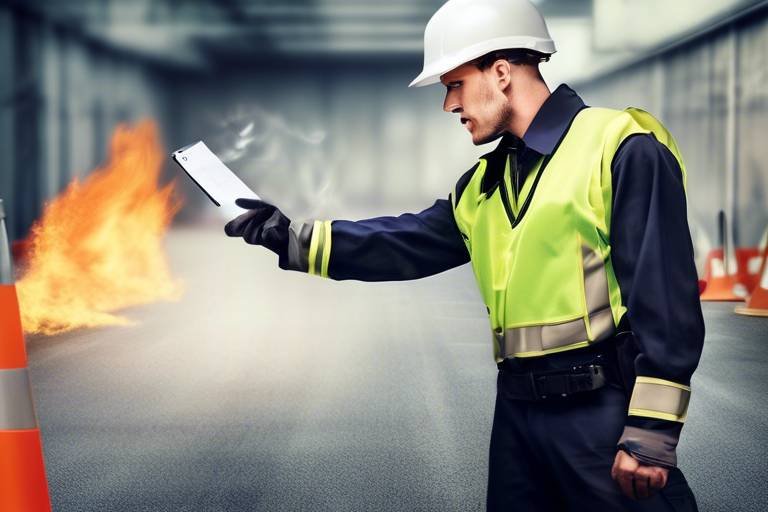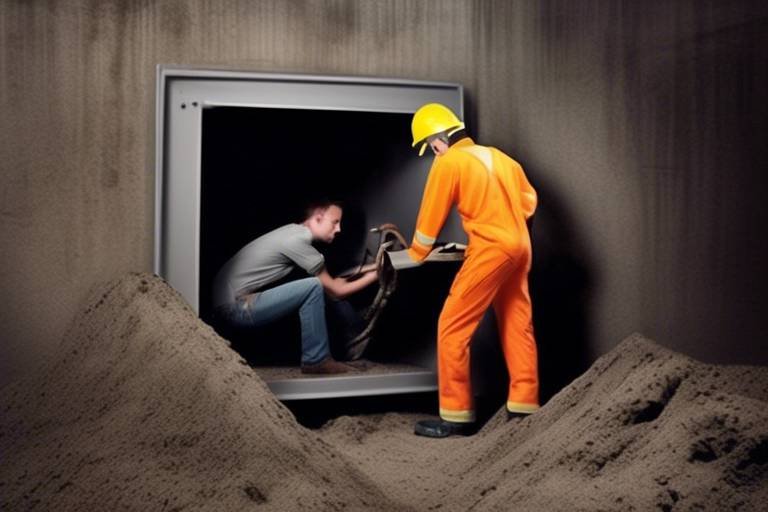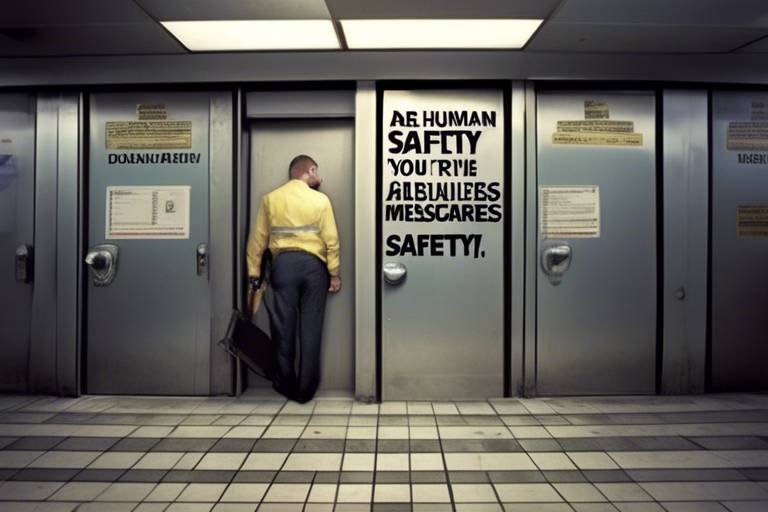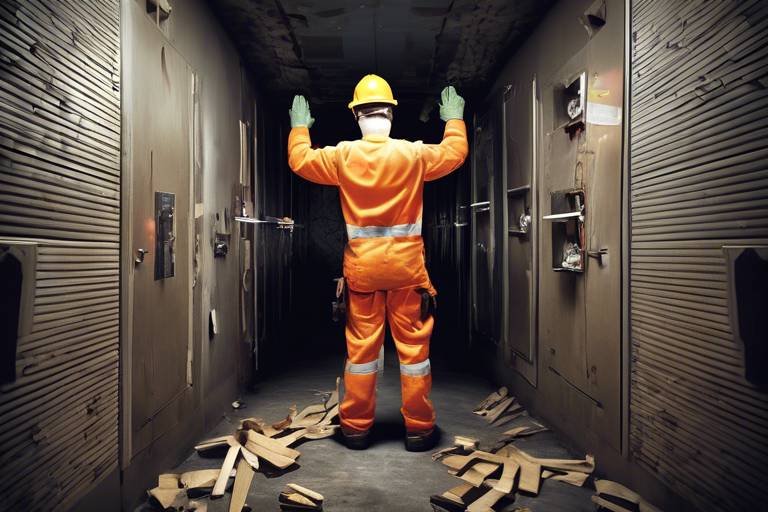Exploring the Intersection of Human Behavior and Safety
In our daily lives, safety is a fundamental concern that often goes unnoticed until something goes wrong. The intersection of human behavior and safety practices is a complex web that influences how we perceive risks and respond to them. Whether it's in our homes, workplaces, or public spaces, understanding the dynamics of human behavior is essential for creating environments that prioritize safety. This article delves into the intricate relationship between our actions, societal norms, and the safety measures we adopt, ultimately aiming to enhance our overall well-being.
At the heart of this exploration lies the critical question: How do our behaviors shape our safety practices? To answer this, we must consider various psychological factors that influence our decisions. For instance, cognitive biases often cloud our judgment, leading us to underestimate risks or dismiss safety protocols. Emotional responses, such as fear or overconfidence, can further complicate our understanding of danger. By examining these psychological elements, we can develop more effective safety protocols that resonate with individuals on a deeper level.
Moreover, societal norms play a pivotal role in shaping our safety behaviors. The values and beliefs of our communities can either promote safe practices or contribute to a culture of risk-taking. For example, in some cultures, there may be a strong emphasis on individualism, which can lead to a disregard for collective safety measures. Conversely, communities that prioritize collective responsibility often see better adherence to safety practices. This article will explore how these societal influences can be harnessed to foster a culture of safety that benefits everyone.
As we navigate through the various environments where safety is paramount, it becomes clear that human behavior is both a challenge and an opportunity. By understanding the psychological and societal factors at play, we can implement safety measures that are not only effective but also align with the behaviors and motivations of individuals. This holistic approach to safety can lead to a significant reduction in accidents and an overall enhancement of well-being.
In the sections that follow, we will delve deeper into the psychology of risk perception, the importance of behavioral safety practices, and the societal influences that shape our safety behaviors. Through this exploration, we aim to uncover actionable insights that can lead to safer environments for all.
- What is the relationship between human behavior and safety? Human behavior significantly influences safety practices, as individuals' perceptions of risk and their adherence to safety protocols are shaped by psychological and societal factors.
- How can we improve safety in the workplace? By focusing on behavioral safety practices, providing effective training, and fostering a culture of safety, organizations can significantly reduce accidents and enhance overall safety.
- What role does community play in safety? Communities that engage in safety initiatives foster a collective responsibility, leading to improved safety practices and a greater awareness of risks.
- How can media campaigns influence safety awareness? Media campaigns can effectively raise public awareness about safety risks and promote safer behaviors by shaping perceptions and providing crucial information.

The Psychology of Risk Perception
Understanding how individuals perceive risks is crucial for developing effective safety protocols. Our perception of risk isn't just about the actual dangers present; it's heavily influenced by a myriad of psychological factors and cognitive biases. For instance, when faced with a potential hazard, our brains often rely on shortcuts, or heuristics, that can lead us to overestimate or underestimate the actual level of danger. This phenomenon can be likened to wearing tinted glasses; the world appears different based on the color of the lenses we choose.
One of the most significant cognitive biases affecting risk perception is the availability heuristic. This is the tendency to judge the likelihood of an event based on how easily examples come to mind. For example, if someone frequently watches news reports about airplane crashes, they may perceive flying as more dangerous than it statistically is, simply because those tragic events are more memorable. This is a classic case of our emotions hijacking rational thought, leading us to make decisions that may not align with the actual risks involved.
Another critical factor is the affect heuristic, where our feelings towards a particular activity heavily influence our perception of its risk. If we enjoy a particular sport or activity, we might downplay its dangers, whereas if we have a fear of it, we might overestimate the risks. This emotional connection can create a skewed perception of safety that affects our decision-making processes. It's essential to recognize these biases to develop effective safety measures that resonate with individuals' true perceptions of risk.
Moreover, societal influences also play a significant role in shaping our risk perceptions. Cultural norms and community values can either amplify or diminish our sense of safety. For instance, in communities where safety is prioritized and openly discussed, individuals may feel more empowered to engage in safe practices. Conversely, in environments where risky behaviors are normalized, individuals might become desensitized to potential dangers, leading to a culture of complacency.
To illustrate these concepts, consider the following table that summarizes various cognitive biases and their impact on risk perception:
| Cognitive Bias | Description | Impact on Risk Perception |
|---|---|---|
| Availability Heuristic | Judging likelihood based on memorable examples | Overestimation of risk due to vivid media coverage |
| Affect Heuristic | Influence of emotions on risk assessment | Underestimation or overestimation based on personal feelings |
| Optimism Bias | Believing negative events are less likely to happen to oneself | Complacency in risky situations |
| Pessimism Bias | Believing that negative events are more likely to occur | Overcaution leading to avoidance of beneficial activities |
In conclusion, the psychology of risk perception is a complex interplay of cognitive biases, emotional factors, and societal influences. By understanding these elements, we can design safety protocols that not only address the actual risks but also resonate with individuals' perceptions and feelings. This understanding is crucial for fostering a culture of safety where individuals feel empowered to make informed decisions about their well-being.
- What is the availability heuristic? The availability heuristic is a mental shortcut that relies on immediate examples that come to mind when evaluating a specific topic, concept, method, or decision.
- How does emotion affect risk perception? Emotions can significantly influence how we perceive risks, often leading us to either underestimate or overestimate dangers based on our feelings about a particular activity.
- Why is understanding risk perception important? Understanding risk perception helps in developing effective safety protocols and educational programs that align with how people actually think and feel about risks.

Behavioral Safety Practices
When we think about safety, it’s easy to focus on the physical aspects—like wearing helmets or using safety equipment. However, the real game-changer often lies in our . This means understanding how our actions, choices, and even our mindset can significantly influence safety outcomes in various environments, especially in workplaces. The crux of behavioral safety is to create a culture where safety is not just a checklist but a way of life. Imagine a workplace where everyone is not just aware of the safety protocols but actively engages in them, looking out for one another like a family. This is the essence of behavioral safety.
Behavioral safety practices focus on the human element, emphasizing that most accidents are a result of unsafe behaviors rather than unsafe conditions. By addressing the psychological factors that drive these behaviors, organizations can create a safer environment. For instance, a study showed that when employees feel empowered and valued, they are more likely to follow safety protocols. It’s like teaching a child to ride a bike; when they feel confident and supported, they are less likely to fall. In the workplace, this translates to a culture where safety is prioritized, and employees feel responsible for their own safety and that of their colleagues.
To effectively implement behavioral safety practices, organizations must invest in training and awareness programs. These programs are designed to educate employees about the risks they face and the best practices to mitigate those risks. Think of it as equipping a soldier with the necessary skills and knowledge before sending them into battle. The more informed they are, the better prepared they will be to handle challenges. Training can include workshops, seminars, and hands-on demonstrations, all aimed at reinforcing safe behaviors.
Effective training is not just about delivering information; it's about engagement and retention. Organizations can utilize interactive learning techniques, such as simulations and role-playing, to make the training more immersive. For example, a simulation that mimics a hazardous situation can provide employees with a practical understanding of how to respond. This kind of hands-on experience is invaluable, as it allows workers to practice their responses in a safe environment, ensuring they are better prepared for real-life situations. It’s the difference between reading about swimming and actually jumping into the pool.
Interactive learning techniques foster better retention of safety information. These methods encourage active participation, making the learning process more enjoyable and effective. For instance, role-playing scenarios can help employees visualize and practice safe behaviors in a controlled setting. By engaging in these activities, employees are more likely to remember the safety protocols when they encounter similar situations on the job. This approach not only enhances learning but also builds camaraderie among team members, as they work together to solve problems and learn from each other.
Implementing continuous improvement models is crucial for maintaining high safety standards. Regular assessments and feedback loops allow organizations to identify areas for improvement and adapt their safety practices accordingly. It’s like tuning a musical instrument; to produce the best sound, you need to make adjustments regularly. By fostering an environment where feedback is welcomed and acted upon, organizations can ensure that their safety practices evolve alongside their workforce and the challenges they face.
Incentivizing safe behavior can also lead to significant improvements in compliance. When employees are rewarded for following safety protocols, it creates a positive reinforcement loop. This can take many forms, such as recognition programs, bonuses, or even simple shout-outs during team meetings. The key is to make safety a shared goal, where everyone feels invested in the outcome. After all, safety is a collective responsibility, and when everyone plays their part, the workplace becomes a safer place for all.

Training and Awareness Programs
When it comes to promoting safety in any environment, are the backbone of effective safety practices. These programs are designed to educate individuals about potential hazards and the best practices to mitigate those risks. But why is it that some organizations excel in safety while others struggle? The answer often lies in the quality and accessibility of their training initiatives. Think of training as the compass that guides individuals through the often treacherous waters of workplace safety. Without it, employees may find themselves adrift, unaware of the dangers lurking around them.
Effective training programs are not just about delivering information; they are about engaging individuals and fostering a culture of safety. This means incorporating various learning styles to cater to a diverse workforce. For instance, some employees may learn better through visual aids, while others might prefer hands-on experiences. By utilizing a blend of teaching methods, organizations can ensure that safety information resonates with everyone. Here are some key elements that make training programs successful:
- Relevance: Training should be tailored to the specific risks associated with the workplace.
- Engagement: Interactive sessions that encourage participation can lead to better retention of information.
- Feedback: Providing opportunities for employees to share their thoughts can enhance the training process.
Moreover, the implementation of interactive learning techniques can significantly improve the effectiveness of training programs. For example, simulations and role-playing exercises allow employees to practice their responses to real-life scenarios in a safe environment. This hands-on approach not only boosts confidence but also reinforces the knowledge gained during training. Imagine a firefighter practicing a rescue operation in a controlled setting; they are better prepared to tackle emergencies when they arise.
Another vital aspect of training is the concept of continuous improvement. Safety protocols should not be static; they need to evolve as new risks emerge and as technology advances. Organizations that regularly assess their training programs and seek feedback from participants are more likely to stay ahead of potential hazards. This cycle of assessment and adaptation ensures that safety practices remain relevant and effective. It’s like maintaining a well-tuned engine; regular check-ups can prevent breakdowns and ensure smooth operation.
In conclusion, the importance of training and awareness programs cannot be overstated. They are essential in creating a safety-first culture that empowers individuals to take responsibility for their own safety and that of their colleagues. By investing in comprehensive training initiatives, organizations not only comply with regulations but also foster a workplace where safety is a shared value. And let’s face it, a safe workplace is a productive workplace. So, let’s make sure we equip our teams with the knowledge and skills they need to navigate the complex landscape of safety.
Q: What are the key components of an effective training program?
A: An effective training program should include relevance to the specific workplace, engaging methods, and opportunities for feedback to enhance learning outcomes.
Q: How can interactive learning techniques improve safety training?
A: Interactive techniques, such as simulations and role-playing, allow employees to practice real-life scenarios, leading to better retention of safety information and increased confidence in handling emergencies.
Q: Why is continuous improvement important in safety training?
A: Continuous improvement ensures that training programs evolve with new risks and technologies, keeping safety practices relevant and effective over time.

Interactive Learning Techniques
When it comes to enhancing safety knowledge, traditional training methods often fall short. That’s where step in, transforming mundane safety training into engaging experiences. Imagine sitting in a classroom, listening to a monotonous lecture about safety protocols—yawn! Now, picture this instead: you’re immersed in a simulation that mimics real-life scenarios, allowing you to make decisions and see the consequences of your actions in real-time. This hands-on approach not only makes learning fun but also significantly boosts information retention.
One of the most effective interactive learning techniques is role-playing. By stepping into different roles—be it a safety officer, a worker, or even a manager—participants can gain diverse perspectives on safety issues. This method encourages empathy and understanding, which are crucial for fostering a safety-first culture. Participants can discuss their experiences afterward, creating a rich dialogue that reinforces learning.
Moreover, incorporating gamification into training sessions can spark enthusiasm. Think about it: who doesn’t love a little competition? By introducing elements such as quizzes, points, and leaderboards, organizations can motivate employees to engage actively with safety content. For example, a simple quiz at the end of a training session can help assess knowledge retention while making it feel like a fun challenge rather than a chore.
Another technique worth mentioning is the use of virtual reality (VR). This cutting-edge technology provides a safe space for employees to experience high-risk situations without the actual danger. Imagine a construction worker navigating a simulated site where they can practice identifying hazards without the risk of injury. This immersive experience can be transformative, as it allows individuals to practice their skills in a controlled environment, boosting their confidence and preparedness for real-world situations.
Ultimately, the goal of these interactive learning techniques is to create a culture where safety is prioritized and ingrained in daily practices. By shifting away from passive learning methods and embracing engagement, organizations can cultivate a workforce that is not only knowledgeable but also actively involved in maintaining a safe environment. As we delve deeper into the realm of safety training, it’s clear that making learning interactive is not just an option; it’s a necessity for fostering a proactive safety culture.
- What are interactive learning techniques? Interactive learning techniques involve engaging methods such as simulations, role-playing, and gamification to enhance the learning experience.
- Why are these techniques effective in safety training? They promote active participation, improve retention, and allow individuals to practice skills in a safe environment, making learning more relevant and impactful.
- Can virtual reality be used in safety training? Absolutely! Virtual reality provides immersive experiences that allow employees to practice safety protocols in realistic scenarios without any real-world risks.

Continuous Improvement Models
In the realm of safety, serve as a beacon guiding organizations toward enhanced safety practices. These models are not just about maintaining the status quo; they emphasize an ongoing journey of learning and adaptation. Imagine safety protocols as a living organism that requires constant nurturing and attention. Just like how we adapt our habits based on experiences, organizations must evolve their safety measures in response to new challenges and insights.
At the heart of these models is the concept of feedback loops. By regularly assessing safety practices, organizations can identify weaknesses and areas for improvement. This process is akin to tuning a musical instrument; without regular adjustments, the instrument may sound off-key. Similarly, safety practices must be fine-tuned to ensure they resonate with the current environment and workforce needs.
One effective approach within continuous improvement models is the Plan-Do-Check-Act (PDCA) cycle. This cycle encourages organizations to:
- Plan: Identify safety goals and develop strategies to achieve them.
- Do: Implement the safety measures and monitor their effectiveness.
- Check: Evaluate the results against the expected outcomes.
- Act: Make necessary adjustments to improve safety practices.
By embracing the PDCA cycle, organizations can foster a culture where safety is not just a priority but a shared responsibility. It encourages employees to actively participate in safety discussions and contribute their insights, creating a more inclusive environment. When employees feel their voices are heard, they are more likely to engage in safe behaviors, ultimately reducing the risk of accidents.
Moreover, regular assessments and data analysis play a significant role in continuous improvement. By collecting and analyzing incident reports, near misses, and safety audits, organizations can uncover trends and patterns that may not be immediately apparent. This data-driven approach enables organizations to make informed decisions, ensuring that safety measures are both effective and relevant.
In conclusion, implementing continuous improvement models in safety practices is not merely a checkbox exercise; it is a commitment to fostering a culture of safety that evolves with time. Organizations that prioritize continuous improvement are better equipped to respond to challenges, adapt to changes, and ultimately safeguard their most valuable asset: their people.
Q1: What is a continuous improvement model?
A continuous improvement model is a systematic approach to enhancing safety practices by regularly assessing and refining protocols based on feedback and data analysis.
Q2: How does the PDCA cycle work?
The PDCA cycle involves planning safety goals, implementing measures, checking the results, and acting on the findings to improve safety practices continuously.
Q3: Why is employee involvement important in safety practices?
Employee involvement fosters a sense of ownership and responsibility towards safety, leading to more proactive engagement and a reduction in accidents.
Q4: How can data analysis improve safety measures?
Data analysis helps organizations identify trends and patterns in safety incidents, allowing for informed decision-making and targeted improvements in safety protocols.

Incentives for Safe Behavior
When it comes to promoting safety in any environment, one of the most effective strategies is to implement . Think about it: just like how a little reward can motivate a child to clean their room, adults too respond positively when their good actions are recognized and rewarded. The psychology behind this is simple yet powerful—when people feel appreciated for their efforts, they are more likely to continue those behaviors. This creates a ripple effect, enhancing the overall safety culture within an organization or community.
Organizations can adopt various incentive programs tailored to their specific settings. For instance, some companies have successfully implemented reward systems that offer bonuses or other perks to employees who consistently follow safety protocols. These incentives can range from simple recognition in company newsletters to substantial monetary bonuses or even extra time off. The key is to ensure that the rewards are desirable enough to motivate individuals to prioritize safety in their daily routines.
Moreover, it's crucial to communicate the criteria for earning these incentives clearly. When employees understand what behaviors are being rewarded, they are more likely to align their actions accordingly. For example, consider a workplace that tracks safety incidents. If employees know that reporting near misses or unsafe conditions can lead to rewards, they may be more inclined to speak up, ultimately fostering a safer environment for everyone.
Another effective strategy is to create a peer recognition program. This approach allows coworkers to nominate each other for safety-related awards. When employees recognize their peers for safe behavior, it not only boosts morale but also strengthens team cohesion. It’s like building a safety net where everyone is looking out for one another, creating a culture of collective responsibility.
To illustrate the impact of these incentive programs, let’s take a look at a hypothetical table showcasing the results of a safety incentive program implemented in a manufacturing company:
| Year | Accidents Reported | Incentives Given | Employee Satisfaction |
|---|---|---|---|
| 2020 | 25 | $5,000 | 70% |
| 2021 | 15 | $10,000 | 85% |
| 2022 | 5 | $15,000 | 90% |
This table highlights a downward trend in reported accidents as the incentives increased over the years. Not only did the number of accidents decrease, but employee satisfaction also saw a significant improvement, demonstrating that when employees feel valued, they are more engaged in maintaining a safe workplace.
In conclusion, implementing incentives for safe behavior is a win-win situation. It encourages individuals to take safety seriously and fosters a culture where everyone is invested in creating a safer environment. By recognizing and rewarding safe practices, organizations can significantly reduce accidents and enhance overall well-being. So, why not take that step today and start building a safer tomorrow?
- What types of incentives can be offered for safe behavior? Incentives can range from monetary bonuses, extra time off, gift cards, or public recognition within the organization.
- How can I measure the effectiveness of an incentive program? Tracking metrics such as the number of reported incidents, employee satisfaction surveys, and participation rates in safety training can help measure effectiveness.
- What role does employee feedback play in incentive programs? Employee feedback is crucial for understanding what motivates staff and can help tailor incentive programs to be more effective.

Societal Influences on Safety Behavior
When we think about safety, it’s easy to focus solely on rules and regulations, but have you ever considered how societal influences shape our safety behaviors? It's fascinating how the values and norms of a community can dictate what we perceive as safe or risky. For instance, in some cultures, wearing helmets while biking is a common practice, while in others, it may be seen as unnecessary. This disparity highlights the importance of understanding the societal backdrop against which safety behaviors are enacted. Our social environment plays a pivotal role in influencing individual and collective safety practices, often in ways we might not even realize.
One major factor that contributes to safety behavior is the community’s shared values. When a community collectively prioritizes safety, it creates a ripple effect. People are more likely to adopt safe practices when they see their neighbors doing the same. For example, if a neighborhood organizes regular safety drills or workshops, it not only educates individuals but also fosters a culture of safety that permeates through families and social circles. This communal approach can significantly reduce accidents and improve overall safety awareness.
Moreover, societal norms can either promote or hinder safety behaviors. Take, for example, the concept of peer pressure. In environments where risky behaviors are glamorized—like reckless driving or substance abuse—individuals may feel compelled to conform, often at the expense of their safety. Conversely, when safe practices are celebrated and recognized, such as through community awards for safe driving or participation in safety programs, it encourages others to follow suit. This creates a positive feedback loop that reinforces safe behavior.
Another crucial aspect is the role of media in shaping perceptions of safety. The information we consume through news outlets, social media, and advertising can significantly impact how we view risks. For instance, sensationalized news reports about crime can lead to heightened fear and overestimation of danger, which may cause individuals to take unnecessary precautions or, conversely, ignore genuine risks. On the other hand, effective media campaigns can promote safety awareness and educate the public on best practices. Consider the success of campaigns aimed at reducing drunk driving; they often feature emotional storytelling that resonates with the audience, leading to a shift in behavior.
In addition to media, community engagement initiatives are vital for fostering a culture of safety. Programs that actively involve community members in safety planning and decision-making not only empower individuals but also create a sense of ownership over safety practices. For example, neighborhood watch programs and local safety committees can help identify specific risks in their areas and develop tailored solutions. This collaborative approach enhances trust and communication among community members, making safety a shared responsibility.
To sum it up, societal influences on safety behavior are multifaceted and deeply intertwined with cultural values, media representations, and community engagement. By recognizing these influences, we can better understand how to cultivate a culture of safety that resonates with individuals and communities alike. It’s not just about following rules; it’s about creating an environment where safety is valued and prioritized by everyone.
- How can community values impact safety practices?
Community values shape individuals' perceptions of risk and safety, influencing behaviors through shared norms and collective actions. - What role does media play in safety awareness?
Media can shape perceptions of safety risks and promote safer behaviors through campaigns that raise awareness and educate the public. - How can communities enhance safety behavior?
By engaging in initiatives that foster collective responsibility, communities can create a culture of safety that encourages individuals to prioritize safe practices.

Community Engagement Initiatives
Community engagement initiatives are vital in fostering a sense of collective responsibility towards safety. When individuals come together, they not only share their knowledge but also create a supportive environment that encourages safer practices. Imagine a neighborhood where everyone watches out for each other—this sense of community can significantly reduce risks and enhance overall safety. Initiatives can take many forms, from neighborhood watch programs to community safety workshops, all aimed at bringing people together to focus on safety.
One effective approach is organizing safety fairs, where community members can learn about various safety topics through interactive booths and demonstrations. These events not only educate but also build relationships among residents, promoting a culture of safety. For instance, a local fire department might set up a booth demonstrating fire safety, while a nearby health organization could provide information on first aid. Such collaborative efforts amplify the message that safety is a shared responsibility.
Moreover, community engagement can also extend to digital platforms. Social media campaigns can encourage residents to share safety tips or report hazards in real-time. This not only raises awareness but also empowers individuals to take action. A simple hashtag can unite a community around a common cause, making safety a topic of everyday conversation. For example, a campaign like #SafeNeighborhood can encourage residents to post about local safety improvements or share their experiences, creating a ripple effect of awareness and action.
It's important to recognize that different communities may require tailored approaches to engagement. For instance, urban areas may benefit from different strategies compared to rural communities. Understanding the unique characteristics of a community is crucial for designing effective initiatives. Here are some key elements that can make community engagement initiatives successful:
- Inclusivity: Ensure that all community members, regardless of age or background, have opportunities to participate.
- Feedback Mechanisms: Create channels for residents to voice their concerns and suggestions regarding safety.
- Collaboration: Partner with local organizations, schools, and businesses to amplify efforts and resources.
- Visibility: Use local events and gatherings to promote safety initiatives and encourage participation.
In conclusion, community engagement initiatives are more than just programs; they are the heartbeat of a safe community. By fostering collaboration and open communication, communities can create a culture where safety is prioritized. When residents feel connected and empowered, they are more likely to take proactive measures to ensure their own safety as well as that of their neighbors. Ultimately, a united community is a safer community.
Q: What are community engagement initiatives?
A: Community engagement initiatives are programs or activities designed to involve community members in safety-related discussions and actions, promoting a culture of safety and shared responsibility.
Q: How can I get involved in community safety initiatives?
A: You can participate by attending local safety meetings, volunteering for community safety events, or joining neighborhood watch programs. Engaging with local organizations can also provide opportunities to contribute to safety efforts.
Q: Why is community engagement important for safety?
A: Community engagement fosters collaboration, increases awareness of safety issues, and encourages individuals to take responsibility for their environment, ultimately leading to a safer community.
Q: Are there any successful examples of community engagement initiatives?
A: Yes, many communities have successfully implemented initiatives like safety fairs, neighborhood watch programs, and digital safety campaigns that have significantly improved local safety outcomes.

Media's Role in Safety Awareness
The media plays a pivotal role in shaping our understanding of safety and risk. Think about it: when a significant event occurs, whether it’s a natural disaster, a public health crisis, or a workplace accident, the media is often the first source of information we turn to. This immediate access to information can be a double-edged sword. On one hand, timely reporting can save lives by informing the public about dangers and necessary precautions. On the other hand, sensationalized coverage can lead to heightened fear and anxiety, distorting our perception of risk.
For instance, consider how news outlets cover road safety. A tragic accident may receive extensive media coverage, leading to increased public awareness about road safety measures. However, if the coverage is overly dramatic, it might cause people to perceive driving as inherently dangerous, even if statistically, it remains one of the safest modes of transportation. This is where the responsibility of the media comes into play. They must balance the need to inform the public with the necessity of providing accurate, contextual information to avoid creating unnecessary panic.
Moreover, media campaigns can be instrumental in promoting safety awareness. From public service announcements to social media campaigns, these initiatives can effectively reach a wide audience. For example, campaigns focusing on seatbelt use have been shown to increase compliance rates significantly. These campaigns often employ emotional appeals, statistics, and real-life stories to resonate with the audience. By highlighting the consequences of unsafe behavior through relatable narratives, the media can influence public attitudes towards safety.
Additionally, the rise of digital media has transformed how safety information is disseminated. Social media platforms allow for real-time updates and community engagement, creating a more interactive experience. This can foster a sense of community responsibility towards safety. For instance, neighborhood watch programs often utilize platforms like Facebook or Nextdoor to share safety tips and report suspicious activities, thereby enhancing collective vigilance.
To illustrate the impact of media on safety awareness, consider the following table that summarizes different types of media and their effectiveness in promoting safety messages:
| Media Type | Effectiveness | Examples |
|---|---|---|
| Television | High | Public service announcements, news reports |
| Social Media | Very High | Campaigns, community engagement posts |
| Print Media | Moderate | Brochures, flyers, newspaper articles |
| Radio | Moderate | Public service announcements, interviews |
In conclusion, the media holds significant power in shaping safety awareness and behavior. It can educate, inform, and mobilize the public towards safer practices. However, with that power comes the responsibility to present information accurately and thoughtfully. As consumers of media, we must also be critical of the information we receive, understanding that not everything portrayed is a reflection of reality. By fostering a symbiotic relationship between the media and the public, we can create a safer environment for everyone.
- How does the media influence public perception of safety?
The media shapes our understanding of risks and safety through coverage of events and safety campaigns, impacting how we perceive and respond to dangers. - What role do social media platforms play in safety awareness?
Social media allows for real-time updates and community engagement, enhancing collective responsibility and awareness of safety issues. - Are sensationalized media reports harmful?
Yes, sensationalized coverage can distort public perception of risk, leading to unnecessary fear and anxiety about safety. - How can I critically evaluate safety information from the media?
Consider the source, check for supporting evidence, and look for balanced reporting that provides context rather than just sensational headlines.
Frequently Asked Questions
- What is the significance of understanding human behavior in safety practices?
Understanding human behavior is crucial because it helps identify how people perceive risks and respond to safety measures. By grasping these psychological factors, organizations can tailor their safety protocols to be more effective and resonate better with individuals.
- How do cognitive biases affect risk perception?
Cognitive biases can distort our understanding of risks, leading us to underestimate or overestimate dangers. For instance, the optimism bias might make someone believe that accidents won’t happen to them, which can result in unsafe behaviors. Recognizing these biases is key to developing strategies that encourage safer practices.
- What are behavioral safety practices?
Behavioral safety practices focus on the actions and behaviors of individuals within a workplace. By promoting safe behaviors and creating a culture of safety, organizations can significantly reduce accidents and enhance overall safety standards.
- Why are training and awareness programs important?
Training and awareness programs are vital because they educate individuals about potential safety risks and the best practices to mitigate them. These programs help instill a safety-first mindset, ensuring that everyone understands their role in maintaining a safe environment.
- What role do interactive learning techniques play in safety training?
Interactive learning techniques, such as simulations and role-playing, make training more engaging and memorable. These methods allow participants to experience real-life scenarios, enhancing their ability to retain safety information and apply it effectively in their environments.
- How does continuous improvement contribute to safety practices?
Continuous improvement ensures that safety practices are regularly assessed and updated based on feedback and new information. This iterative process helps organizations adapt to changing conditions and maintain high safety standards over time.
- What are some effective incentives for promoting safe behavior?
Incentives for safe behavior can include rewards such as bonuses, recognition programs, or additional time off. These rewards encourage individuals to prioritize safety and comply with established protocols, ultimately leading to a safer workplace.
- How do societal influences shape safety behaviors?
Societal norms and cultural factors significantly influence how individuals perceive and engage in safety practices. Community values can either promote a culture of safety or contribute to negligence, making it essential to understand these influences when developing safety initiatives.
- What are community engagement initiatives in the context of safety?
Community engagement initiatives involve actively involving community members in safety programs and activities. These initiatives foster a sense of collective responsibility, encouraging individuals to work together to improve public safety and awareness.
- How does the media impact safety awareness?
The media plays a powerful role in shaping public perception of safety risks. Effective media campaigns can raise awareness, inform the public about best practices, and promote safer behaviors, ultimately leading to improved community safety.


















